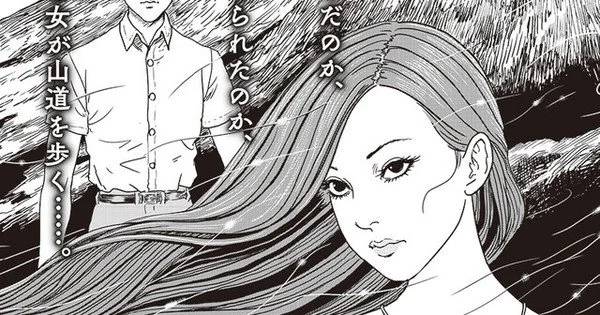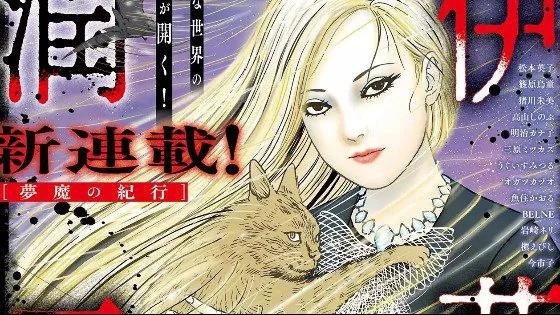I first came across Travelogue of the Succubus on ComicK, and to be honest, I wasn’t sure what I was walking into. I’ve read my fair share of horror manga, but nothing prepared me for the sense of creeping unease and otherworldly dread this series left behind. Unlike quick scare tactics or predictable horror beats, this story demands patience it slowly builds a surreal tension that grips tighter with each chapter.
Reading it felt less like flipping through a manga and more like being swallowed whole by an atmosphere. The story begins at Mount Sengoku with Kyoko Byakuya’s strange encounter, and right from the start, there’s an unnerving sense that reality itself is slipping. The golden angel hair covering the village feels too beautiful to be natural, and yet it carries a sinister weight.
What made me fall deeper into this manga is the way Ito stretches his narrative. He doesn’t rush toward scares. Instead, he allows the dread to simmer, blending horror with a mythic, almost spiritual edge. By the end of the first few chapters, I knew this wasn’t just another horror manga it was a complete experience in itself.
The Allure of Kyoko Byakuya and Her Mysterious Fate
Kyoko Byakuya is one of the most enigmatic protagonists I’ve seen in a horror series. She isn’t just a character trapped in a nightmare she feels like the catalyst of it all. The villagers’ devotion to her as a “messianic savior” raises countless questions: is she chosen, cursed, or simply unlucky to stumble into this cosmic web?
The brilliance of Ito’s storytelling is that Kyoko is never presented with clear answers. Her role seems fated yet coincidental, divine yet terrifying. The uncertainty surrounding her purpose in the village mirrors the way readers experience the story always slightly in the dark, always one step behind.
Personally, I found myself empathizing with her confusion while simultaneously fearing what her existence might unleash. She’s not the kind of heroine who fights her way out; instead, she becomes a symbol of something larger, something terrifyingly incomprehensible. That duality is what makes her unforgettable.

Horror Beyond the Human Scale
Junji Ito’s work often thrives on grotesque close encounters, but here, he pushes the boundaries into cosmic horror. We’re not just talking about demons lurking in shadows this story deals with forces so immense and abstract that they redefine the idea of fear.
The introduction of “The Black Hair” cult and their apocalyptic ambitions makes the manga feel like a battle between incomprehensible entities. The horror isn’t confined to a haunted house or a cursed town it’s sprawling, touching everything from volcanic eruptions to cosmic manifestations in the farthest reaches of space.
What struck me most was how small the characters felt in comparison. Ito emphasizes this scale through his visuals: wide shots of cosmic voids, detailed close-ups of terror, and the sheer fragility of human existence. It’s not about surviving the monster in front of you—it’s about realizing the universe itself is monstrous.
Twists of Terror: From Suicide Bugs to Mirror Stalkers
Every chapter of Travelogue of the Succubus introduces an unsettling set piece that escalates the horror. From the suicide bugs deliberately throwing themselves underfoot to the eerie woman in black haunting mirrors, the manga never lets you settle into a single rhythm of fear.
The mirror stalker in particular left a mark on me. There’s something bone-chilling about the idea that your own reflection could betray you, that a shadow could slip free and chase you through the streets. These episodes aren’t just meant to shock they linger in your mind long after you’ve closed the book.
What impressed me most is how these grotesque elements don’t feel disconnected. Each disturbing vignette feeds back into the larger narrative, weaving smaller terrors into the overarching cosmic doom. It’s a masterclass in pacing and atmosphere, making you feel constantly off-balance.

A Slow-Burning Narrative with Heavy Rewards
Unlike some of Ito’s short stories that end in a single, shocking climax, Travelogue of the Succubus unfolds through episodic chapters that build on each other. The pacing may feel slow at first, but that’s exactly why the horror works it sneaks under your skin before you realize what’s happening.
Each new character and subplot adds a fresh layer of dread, whether it’s the cultists scheming in the shadows or the reporter Wataru chasing fragments of truth. Instead of being disposable side characters, they bring dimension to the central mystery and intensify the sense of an unstoppable fate.
I’ll admit, I usually prefer Ito’s shorter, sharper tales. But here, the length becomes part of the experience. By the time I reached the later chapters, I felt completely immersed in a universe where doom wasn’t just imminent it was inevitable. That payoff is worth every lingering panel.
Why This Manga Stays With You
The true terror of Travelogue of the Succubus isn’t the monsters or even the cult. It’s the sense of helplessness, the realization that no matter how much you fight, some forces are simply beyond human control. Ito doesn’t just scare you he humbles you.
Even after finishing, I found myself thinking about its imagery: the golden threads drifting in the air, the woman in black reflected in a passing window, the abyss that seemed to swallow entire landscapes. They stay burned into your memory, resurfacing when you least expect them.
If you’re a horror fan looking for a story that challenges the boundaries of the genre, this manga is a must-read. ComicK makes it easy to dive into, but be warned it’s not just entertainment. It’s an experience that will haunt you in the quietest hours of the night.
Read more:
- Outsiders Manga Review: A Vampire Tale with a Twist
- Brain Damage Review: Shintaro Kago’s Darkest Stories
